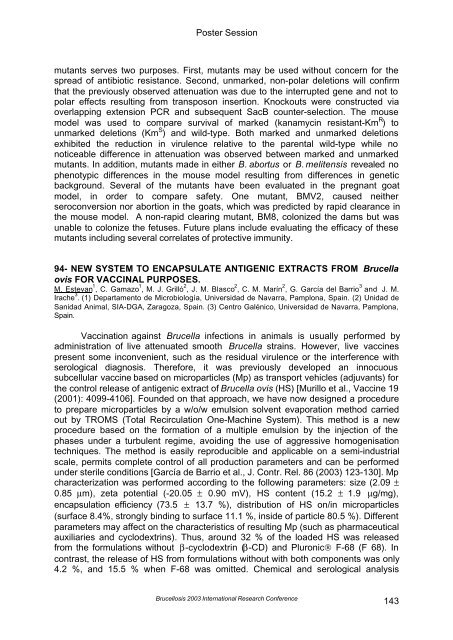Brucellosis 2003 proceedings - PHIDIAS
Brucellosis 2003 proceedings - PHIDIAS
Brucellosis 2003 proceedings - PHIDIAS
Create successful ePaper yourself
Turn your PDF publications into a flip-book with our unique Google optimized e-Paper software.
Poster Session<br />
mutants serves two purposes. First, mutants may be used without concern for the<br />
spread of antibiotic resistance. Second, unmarked, non-polar deletions will confirm<br />
that the previously observed attenuation was due to the interrupted gene and not to<br />
polar effects resulting from transposon insertion. Knockouts were constructed via<br />
overlapping extension PCR and subsequent SacB counter-selection. The mouse<br />
model was used to compare survival of marked (kanamycin resistant-Km R ) to<br />
unmarked deletions (Km S ) and wild-type. Both marked and unmarked deletions<br />
exhibited the reduction in virulence relative to the parental wild-type while no<br />
noticeable difference in attenuation was observed between marked and unmarked<br />
mutants. In addition, mutants made in either B. abortus or B. melitensis revealed no<br />
phenotypic differences in the mouse model resulting from differences in genetic<br />
background. Several of the mutants have been evaluated in the pregnant goat<br />
model, in order to compare safety. One mutant, BMV2, caused neither<br />
seroconversion nor abortion in the goats, which was predicted by rapid clearance in<br />
the mouse model. A non-rapid clearing mutant, BM8, colonized the dams but was<br />
unable to colonize the fetuses. Future plans include evaluating the efficacy of these<br />
mutants including several correlates of protective immunity.<br />
94- NEW SYSTEM TO ENCAPSULATE ANTIGENIC EXTRACTS FROM Brucella<br />
ovis FOR VACCINAL PURPOSES.<br />
M. Estevan 1 , C. Gamazo 1 , M. J. Grilló 2 , J. M. Blasco 2 , C. M. Marín 2 , G. García del Barrio 3 and J. M.<br />
Irache 3 . (1) Departamento de Microbiología, Universidad de Navarra, Pamplona, Spain. (2) Unidad de<br />
Sanidad Animal, SIA-DGA, Zaragoza, Spain. (3) Centro Galénico, Universidad de Navarra, Pamplona,<br />
Spain.<br />
Vaccination against Brucella infections in animals is usually performed by<br />
administration of live attenuated smooth Brucella strains. However, live vaccines<br />
present some inconvenient, such as the residual virulence or the interference with<br />
serological diagnosis. Therefore, it was previously developed an innocuous<br />
subcellular vaccine based on microparticles (Mp) as transport vehicles (adjuvants) for<br />
the control release of antigenic extract of Brucella ovis (HS) [Murillo et al., Vaccine 19<br />
(2001): 4099-4106]. Founded on that approach, we have now designed a procedure<br />
to prepare microparticles by a w/o/w emulsion solvent evaporation method carried<br />
out by TROMS (Total Recirculation One-Machine System). This method is a new<br />
procedure based on the formation of a multiple emulsion by the injection of the<br />
phases under a turbulent regime, avoiding the use of aggressive homogenisation<br />
techniques. The method is easily reproducible and applicable on a semi-industrial<br />
scale, permits complete control of all production parameters and can be performed<br />
under sterile conditions [García de Barrio et al., J. Contr. Rel. 86 (<strong>2003</strong>) 123-130]. Mp<br />
characterization was performed according to the following parameters: size (2.09 ±<br />
0.85 µm), zeta potential (-20.05 ± 0.90 mV), HS content (15.2 ± 1.9 µg/mg),<br />
encapsulation efficiency (73.5 ± 13.7 %), distribution of HS on/in microparticles<br />
(surface 8.4%, strongly binding to surface 11.1 %, inside of particle 80.5 %). Different<br />
parameters may affect on the characteristics of resulting Mp (such as pharmaceutical<br />
auxiliaries and cyclodextrins). Thus, around 32 % of the loaded HS was released<br />
from the formulations without β-cyclodextrin (β-CD) and Pluronic® F-68 (F 68). In<br />
contrast, the release of HS from formulations without with both components was only<br />
4.2 %, and 15.5 % when F-68 was omitted. Chemical and serological analysis<br />
<strong>Brucellosis</strong> <strong>2003</strong> International Research Conference<br />
143
















